The revolution began quietly. In 2002, Peak Resorts bought one of New England’s smaller ski areas, Crotched Mountain. There was a little buzz in the press about it, some excitement in the consumer world, and skiing continued as usual, there and around the Northeast.
Fast forward to 2009. Killington gets a run open on November 7. Mount Snow, another Peak Resorts property, opens a lift on October 17. And Sunday River, a perennial champion in the snowmaking steeplechase, gets open on October 14 and stays open. With the exception of Sunday River, everyone else was forced to shut back down due to a blast of unseasonably warm weather…but what’s the deal with all of these early openings??? And what’s the connection with Crotched Mountain?
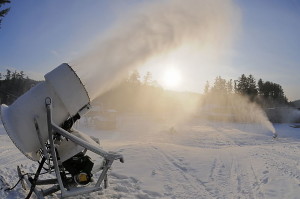
One word (okay, two): Fan guns. Strange looking things…sort of like a jet engine that fell off a DC-10. Short, fat, ugly. Sometimes they’re sitting on the side of a trail, looking like a cannon ready to be towed into battle. Other times, they’re perched on top of a tower like metallic vultures. This isn’t snowmaking as we know it, with long, graceful nozzles arcing in a line over a trail (and spewing a particularly unpleasant wet mix that usually hits you about halfway up the lift, coating your goggles and turning you into a human popsicle). What’s the deal with the fan gun invasion?
Conventional wisdom, if you Google fan guns, says that they’re great at putting out huge amounts of snow for base areas in very cold conditions. Okay, that makes sense, particularly for large ski areas that both need gruntloads of snow around their base areas and have the big bucks to buy fan guns (which come in at somewhere around $10,000 each, on average). But if that’s true, why does an area like Shawnee Peak…or an even smaller area, like King Pine… have them? And what’s the real advantage in New England’s flaky weather, if they only work at cold temperatures?
Time to talk to the experts. Since Crotched Mountain was the first to have fan guns around here, it made sense to start there. And, immediately conventional wisdom took its first blow. Felix Kagi, then VP of that operation, confirmed that yes, their tower fan guns DO allow them to produce snow in marginal conditions, and to blow HUGE amounts of snow when the conditions are optimal. He commented that “they give us the firepower to open up fairly quickly as temperatures allow, to recover quickly from thaw and freeze cycles, and to offer skiing conditions that Mother Nature can’t provide, as well as skiing conditions that are difficult to duplicate with traditional air/water snowmaking systems.”
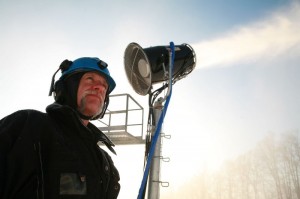
Hmmm. That doesn’t sound like a system that’s only good in bitter cold. In fact, that sounds like a system that’s ideal for solving a dilemma of snowmaking; namely, that it works best when you need it the least. Let’s dig a little deeper into this particular snowbank.
Loon Mountain’s a little farther north in NH, and a lot bigger. They’re known for getting open, staying open, and making sure that the Boston crowd that comes flying up I-93 on Friday afternoon has a good time. Stacy Lopes, the marketing manager there, is enthusiastic about what fan guns bring to Loon. She comments that the fans are great at making quality snow at milder temperatures, as well as blanketing the wide-open trails and base areas. Also, since the fan guns have their own compressors, they don’t add stress to Loon’s conventional snowmaking infrastructure, allowing more snow to be blown when the opportunity arises.
So far, so good. Let’s move over to Maine, where…well, let’s face it, Sunday River blows the most snow. Might as well see what they have to say. They’ve probably put more money into snowmaking infrastructure over the past decade than the Department of Transportation has into road infrastructure (but that’s a different problem entirely), so they wouldn’t need ridiculously expensive fan guns to take stress off the conventional air/water guns, right?
Wrong. Darcy Liberty, spokesperson over there, said that “fan guns allow us to produce drier snow at higher temperatures, which disputes the conventional wisdom that they aren’t good in marginal temperatures.” Well, it’s hard to argue with that assertion, given the skiing so far this year at Sunday River! And go take a look at South Ridge…from the base area, you can see a ton of Boyne Low-E fan guns (given that Boyne owns Sunday River, this makes a lot of sense!).
So far, so good. Every area that’s using them says that they do a better job in marginal conditions…but why? Again, the word on the street is that they don’t work as well when temperatures are hovering near the freezing mark. What’s going on that makes them so effective here in New England…is it magic?
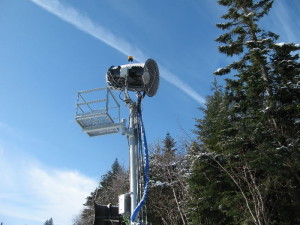
The answer appears to be in how the fan guns are applied. Randy Barrows, head of snowmaking at Mount Snow, says that the biggest factor is in how the guns are nozzled. In his ideal world, he gets water that’s at 38-40 degrees, and temperatures above 20 degrees, and produces better quality than he can get with conventional guns. Also, by using tower mounted guns, they can shoot the water as much as 40 feet in the air, giving the new snow more time to literally dry out before it hits the ground. Dry snow, more loft, and suddenly “packed powder” isn’t code for “icy stuff”.
Of course, Mount Snow is a big area…they’ve got lots of money behind them to put into making things work just right. But what about the smaller areas? I talked with Dan Houde, marketing director over at King Pine, to see what their take is…they’ve got a dozen of these megabuck cannons, and they’re not exactly a high profile area. His experience is that first, the fans are the most efficient guns on the mountain; they pay for themselves to a certain extent because of lower operating costs. And, just as at Mount Snow, they pay close attention to the nozzling. He said “if the air temperature falls, we can add more water by using a series of valves, making more snow without using any more air.” Given that the air compressor is usually the limiting factor in a snowmaking system, that’s a big boost to capacity as well as temperature flexibility. King Pine also uses an additive called “Snowmax”, which creates a particle for the snow crystal to form around, making the process more efficient and the snowflakes larger than could happen without it.
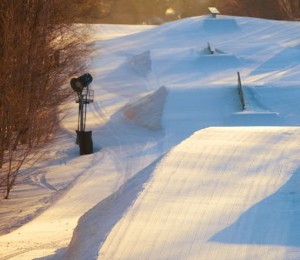
So, it appears that the reason they work so well in New England is the snowmakers themselves. Those guys out there freezing their tails off at night have learned how to ue the fan guns in ways that take the best advantage of our weather here. And the result is better snow, more open trails, and longer seasons for us…not a bad deal! Hmmm…you know, it might be interesting to see exactly how these guys do what they do. And since Peak Resorts really started the revolution in New England, it would make sense to check it out at one of their resorts. Attitash is the closest to me…stand by for an update when I’ve had a chance to go play in the (manmade) snow!


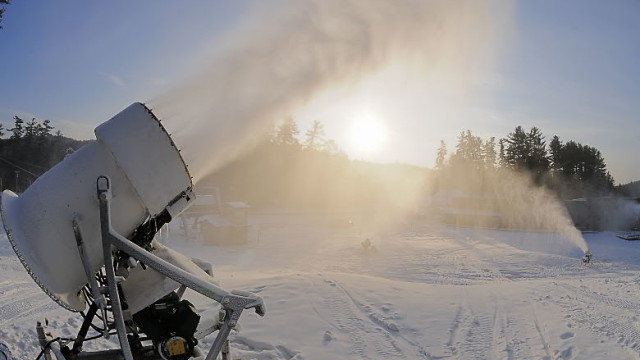
David,
Fan guns are not new to New England, they are just new to the big boys.
We installed fans in 1984 at The Berkshire Snow Basin in Cummington, MA. We had 4 Fan Jets & 3 SMI Highlands. In 1991 I used 2 Lenkos & 1 SMI Highland to cover 3km of cross country trails at Swift River Inn also in Cummington, MA.
You might also want to check out Berkshire East in Charlemont, MA. They have been using fan guns since the late 80s.
I know that some of the ski areas in CT are using fans & have been for sometime now. Matter of fact The Fan Jet guns we used at The Snow Basin were developed in CT.
I understand that now that the big boys are using them it’s now news but, they are not new to New England.
Allan
Allan-
Thanks for reading the article, and for some great background information for our readers. You’re absolutely right…there were lots of areas using them before Peak converted Crotched. But, just as Henry Ford wasn’t the first to build a car but rather changed the game for all consumers, so have the recent investments in fan guns by “the big boys” changed skiing for virtually all skiers in the East. That major investment from a new player to New England (and, frankly, not a “big boy” at that point…all of their other resorts were small) woke up the sleeping giants. Put a different way, the total number of skier visits affected by fan guns in the 80s and 90s is probably less than will be affected this year alone. And, of course, the guns themselves have evolved, becoming more efficient and effective. Hey, if anyone wants me to do an article on the evolution of the fan guns, put in your comments…that might be fascinating!
[…] my experiences talking to snowmakers for the earlier” Fan Guns” article, it was time to get out and actually see them at work. And where better to do it […]
I worked at Powder Ridge in Middlefield CT, in the mid-80s. We had 50 fan jets that were produced by Powder Ridge about 10 years before. They ran into patent issues and had legal troubles on part of the design. When that was finaly resolved and they were ready to go into major productions with world wide contracts in hand, the town of Middlefield put the final nail in the coffin by bringing zoning issues up causing the Zemmels to throw in the towel.
These guns made huge amounts of snow we could pump our pond dry and cover the mountain in a few cold nights.most were 10hp with a turbo type fan made of cast alumnium which was known to explode if it got hit wrong with a chunk of ice build-up . . . those were the days!
Chuck,
I skied at Powder Ridge in the early 90’s and had a wonderful time. I was sad to see it go. What a lovely resource it was for the town and the kids who grew up around there.
I hadn’t heard of their experiment with Fan Guns. Thanks for sharing.
Hi
I am 5th grader and working on my science fair project. Could someone please answer a couple questions for me:
1. what is the most important factor when making fake snow?
2. is it ever too cold to make snow?
3. what is the best temperature to make snow?
thank you
patrick
Patrick, great questions! I went to a real expert, Kevin Kasten, who is the head of snowmaking for Attitash/Bear Peak, for answers; here they are:
1. The TWO most important factors are cold temperatures and good snowmakers. If it’s too warm, it’s not snow; and, if the snowmakers don’t know how to adjust the air/water mix precisely for the conditions, the quality is poor. By the way, snowmakers call it “manmade” snow, not “fake” snow…it’s made of water, just like Mother Nature does it!
2. Yes, it actually, CAN get too cold to make snow. At about -10 degrees F, it becomes very difficult to keep the water lines from freezing.
3. Kevin says that opinions on this differ among snowmakers; however, for him it’s around 10 degrees with a 5 mph wind. Cold enough to make lots of snow, and a little wind dries it out before it hits the ground giving higher quality; but not so cold that there’s equipment problems or so much wind that the snow doesn’t go where they want it.
Keep studying…maybe you’ll take over Kevin’s job someday!
David, When it gets that cold you make the BEST snow. Get a clue
Jim, I’m glad you’re passionate about snowmaking, and I’m certainly clueless about lots of things, but you can’t blame this one on me! The answers came directly from Kevin Kasten, head of snowmaking for Attitash/Bear Peak…and they’ve got a phenomenal system, as well as being part of the company that brought major-league fan gun snowmaking to New England. If you read the comment carefully, you’ll see that he didn’t say they COULDN’T make snow below -10F; just that it becomes much more difficult because the water lines freeze up. And, he clearly likes it cold for snow, since around 10 degrees is his favorite. Hope you’re translating your passion for snowmaking to time on the slopes!
First off, it’s never to cold to make snow. just more difficult. Secondly, you could make snow at 35 degrees with a low humidity and an additive called “Snowmax”
We were using Snowmax at Diamond Peak in the early 90s. We had an Areco that kicked @$$, a Lenko and Turbocristal which I believe were demos, and an SMI model. We only had a few outlets to run them in the lower mountain.